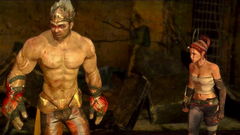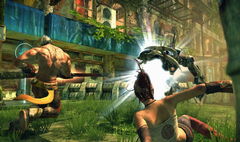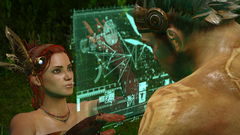 In this age of constant over-exposure and gameplay trailers years in advance (even if it they look fantastic) it’s refreshing to be pleasantly surprised by a game that comes out of nowhere without much fanfare.
In this age of constant over-exposure and gameplay trailers years in advance (even if it they look fantastic) it’s refreshing to be pleasantly surprised by a game that comes out of nowhere without much fanfare.
Until I started hearing rumblings about how great the screenshots and trailers looked, Enslaved: Odyssey To The West wasn’t even on my radar. However, I made sure to download the demo as soon as it dropped, and I was quickly hooked by the gorgeous visuals and engaging combat.
I liked it enough that I used some trade-in credit at GameStop to pick up the full game when it came out, and here I am a few weeks later with a verdict. The short version is that I’d love to see more underdog titles like Enslaved come up from behind to provide a bit of entertainment between the garden-variety triple-A sequel/franchise/FPS releases. Read on to find out more.
Enslaved is set in a post-apocalyptic world filled with slave ships and murderous mechs. Our hero, Monkey, wakes up inside a prison pod after being captured by slavers, and is surprised when a mysterious woman breaks through the security on the ship and unintentionally sets him free. He chases after her as the ship starts falling apart around them, just barely manages to escape, and survives a crash landing only to wake up wearing a slave headband.
The woman, Trip, tells him that she needs him to help her journey the 300 miles to her home, and that the slave headband has been hacked to force him to do her will. Monkey grudgingly agrees to do what she wants (with a promise to break her neck as soon as he gets the headband removed), and the story is set in motion.
Storytelling is actually one of the strongest aspects of Enslaved, and with good reason. The story was written by Alex Garland (28 Days Later, Never Let Me Go) and directed by Andy Serkis (Gollum from The Lord of The Rings). Serkis also did the motion capture and voice -acting for Monkey. The voice-acting is solid all-around, and that combined with some stunning visuals makes for a very cinematic presentation. All that would be for nothing, of course, if the gameplay sucked. Luckily, it (mostly) doesn’t.

One of the main mechanics of the game is platforming, usually involving jumping around from handhold to handhold on some wrecked relic of the past. Handholds are helpfully highlighted with a shimmer, which definitely saved me more than once when I got turned around while exploring. On the other hand, this does make the platforming feel a bit simplistic at times. Monkey can’t really fall off of anything unless it crumbles underneath him, and all you need to do to make it to the next handhold is point in its basic direction when you jump.
Later in the game, things get a bit more complex because you start having to time your jumps to avoid hazards, but in general you won’t find yourself struggling to make it to the next platform. Once I got sucked into the game, this didn’t really bother me much. I feel like bad platforming would be a much worse sin – there’s nothing worse than a game too frustrating to play.
When you aren’t jumping around like your namesake, you spend most of your time battling various mechanical enemies with a few basic melee attacks and a long-range plasma blast. One of the especially cool things about combat is that the camera is very dynamic as you fight, zooming in and tilting sideways in a way that always made me feel like I was playing through a fight scene in a movie.
I did find myself wishing at times that Monkey could learn a few more interesting combo moves, but that might just be because I recently finished playing Bayonetta. I think my only really big complaint is that there isn’t really much variation in the enemies. Mechs are either shielded or unshielded, some shoot at you, and some can stun you with a plasma blast, but in the end they’re all basically just robots that can be fought pretty much the same way. Throwing a few human enemies into the mix would have been a nice change of pace.
The boss battles do offer a little bit of variation, but not much, and one boss battle was so poorly designed that I was worried that the game might be going downhill fast. In one of the first few chapters, you’re chased by a huge mech called a “Dog”, which is basically a house-sized mechanical dog-thing. It’s a fairly intense moment, but is completely deflated a few chapters later when you learn how to beat Dog mechs: stun them, bash them a few times with your staff, and then repeat. It’s so easy that it quickly becomes tedious.

I was actually ready to knock off a letter grade based on that boss battle alone, but within another chapter or two, the game had won me over again. Some of the chapters are fairly tough, but rarely in a way that I found frustrating. Most of the time the game is just a lot of fun. The only time I came close to throwing my controller was a chapter near the end of the game when you have to chase after a boss that has captured Trip. The frustrating part is that you have to do it while riding on a hover-device that likes to veer off course into nearby ravines.
Speaking of Trip, one of the nice things about the game is that she usually does a fairly good job of taking care of herself. She has a decoy that she can use to distract enemies until you get past them, and she is able to stun mechs if they get close enough to attack her. I never felt like I had to babysit her to keep from failing a level, as opposed to Resident Evil 4, when I sometimes wished I could abandon the president’s daughter to fend for herself. Scandalous, I know.
To sum up, Enslaved is definitely something I’d recommend checking out. There are 14 chapters (plus a cinematic epilogue), and each chapter takes around 30-45 minutes to play through, which amounts to about 8-10 hours total. It’s a pretty perfect length, in my opinion. None of the chapters outstay their welcome, but the game doesn’t feel too short. Hopefully it will do well enough commercially that we might see a sequel or another story set in this universe. We definitely need more post-apocalyptic games that use something other than “murky brown” as their entire color palette. I’m looking at you, Gears of Fallout.


B? Surprising. This game kinda came out of nowhere, and is getting pretty good reviews. I might have to check this one out.
Yeah, I played the demo and liked it, but it didn’t really move me.
Your review makes me want to give it another shot.
It’s sort of interesting that this game has come out of nowhere, considering the big-name talent behind it. It seems to have caught on though, which is good publicity for Ninja Theory’s next game, the new Devil May Cry.
Nice review, JJ! I thought it was funny how you brought up the ease of the Dog fight, which is something I’ve heard in every review. Guess they really dropped the ball!
As gorgeous as this game looks on consoles, I’d want to see it running on the PC. I bet it would look so smooth.